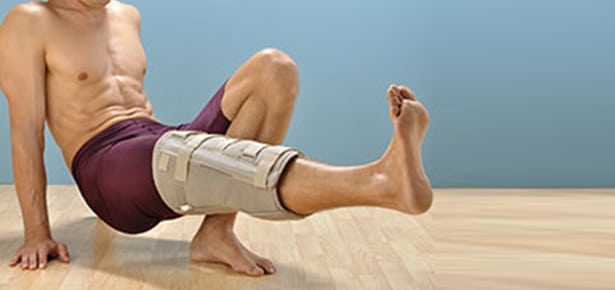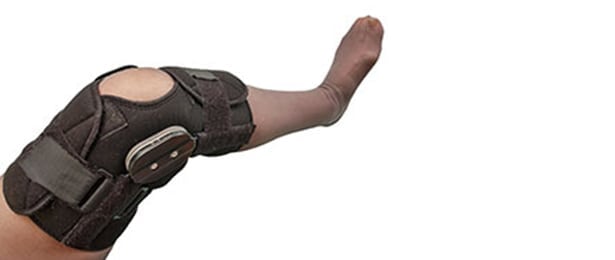
Our knee doctor can help to get you moving again.
Fractures, sprains, dislocations, difficulty maintaining stability, and ligament tears are just some of the reasons why you may be referred to a knee doctor in Orange County. The knee joint itself is fairly complex and susceptible to injury from repetitive activities, stress and strain, and hard falls. The good news is that these remedies can be effective:
- Bracing
- Physical therapy
- Activity modification and rehabilitation
CONTACT US TODAY
What You Need to Know about Your Knee
The knee has the distinction of being the largest single joint in the human body. Due to its prominent location and size, it’s also the most easily injured of the joints in your body, ranking right up there with the joints that support the spine. The knee consists of four main parts, the bone itself and supporting cartilage, tendons, and ligaments.
Three bones connect to form the knee joint, the tibia, or shinbone, the femur, or thighbone, and the patella, or kneecap. Two wedge-shaped pieces of cartilage called the meniscus act as shock absorbers. While the meniscus is durable, it’s still susceptible to injury. If these tough pieces of cartilage are damaged, it’s referred to as a “torn meniscus,” an injury common among athletes.


Common Knee Injuries
Many key structures make up or support the knee. Since the knee itself is integral part of movement, even if you’re not an athlete, injury to any of these structures may result in persistent discomfort. The most common knee injuries are sprains and tears involving soft tissues, fractures, and dislocation of the knee joint or kneecap. Injuries to the knee often involve multiple structures.
Symptoms associated with knee pain, other than the pain itself, typically include swelling and discomfort that comes and goes or appears to be linked to certain movements or activities. Knee injuries can make it difficult to maintain stability while walking; and nearly impossible to resume activities involving running and jumping if the injury is severe.
Initial Treatments
When knee pain is caused by muscle strain and stress, some initial rest and taking a break from strenuous activities should give the knee and its related structures time to heal. If there is swelling, applying ice packs or heat for 15-20 minutes at a time 2-3 times throughout the day for a few days may help. Compression wraps should only be used for 48 to 72 hours. If pain persists longer than that, see your doctor.
If there is an underlying condition involved, such as arthritis, that condition will also need to be addressed and, if possible, managed with medication or other treatments. For instance, patients with arthritis may be given anti-inflammatory drugs to reduce swelling around the knee. A knee doctor in Orange County can perform a thorough evaluation to determine if there are other treatments likely to help a patient.
If you have any questions about your knee and are wondering whether you need to be seen, contact our office. We can give you ideas for managing your pain leading up to your appointment and can get you in as soon as possible.


Managing Knee Pain
Managing knee pain starts with knowing when to see a doctor. You’re not going to do yourself any favors by “pushing through the pain.” Effective pain management starts with a medical examination. If you’re referred to a knee doctor, image testing may be done to either confirm or rule out sources of your pain. Once a source of your knee pain is identified, recommendations for pain management can be given.
Taking control of knee pain involves knowing what activities to avoid and often includes learning proper form and taking steps to warm up before exercising or participating in sports. Using a cane or brace can increase stability and reduce the risk of experiencing a fall. Knee pain can also be reduced and managed by quitting smoking, eating a balanced diet that includes lean proteins and vitamin-rich fruits and vegetables, and getting regular exercise.
Non-Surgical and Surgical Treatments
Physical therapy (PT) is one of the most effective non-surgical treatments for knee pain. PT sessions are tailored to the needs of the patient and typically involve coordination with a knee doctor to ensure that recommended exercises are safe and beneficial. Beyond initial treatments, non-surgical remedies for knee pain can include non-steroidal anti-inflammatory medicines and injections directly into the affected area of the knee.
In some cases, full restoration of knee function may only be possible after surgery, as is often the case with ACL tears and severe meniscus tears. Many types of knee surgery can be done arthroscopically. Arthroscopic procedures involve the use of small instruments, a camera, and several tiny incisions. Regardless of whether or not surgery is your best option, a knee doctor will provide the information you need to determine what steps are likely to restore your quality of life.
Regardless of the extent of your knee pain, it’s not something that should be ignored, especially if it gets worse and doesn’t respond to home remedies. A knee doctor in Orange County can determine the specific source of your pain and recommended appropriate treatments, including some you may not have considered. Take comfort in knowing that surgery is often a last resort, although an option worth considering if other remedies aren’t offering meaningful relief.
If you do need surgery for your knee condition, your knee doctor in Orange County will talk with you about what you can expect and the steps that you need to take in order to prepare for your surgery and recover from it. It is important to follow these steps carefully to get the best results.
To learn more about how we can help you, contact our office today.

